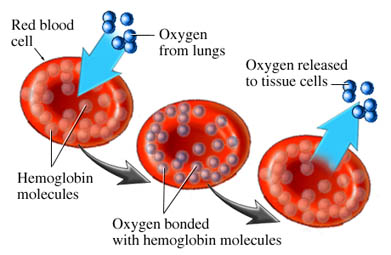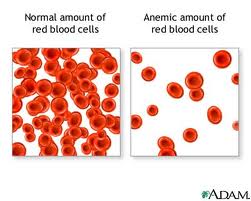Blood Loss and Anemia
Acute blood loss, hemorrhage or anemia are characterized by significant decrease in blood volume and red blood cells – the main oxygen carriers in our body. Resulting lack of oxygen (hypoxia), if left untreated, can seriously harm the organ function. In acute or chronic anemia the body tries to compensate for decreased oxygen supply by producing more red blood cells in bone marrow and extract the liquid from interstitial places. Secondary carrier of oxygen in our body is blood plasma, with only 2% of carrying capacity when to compared to hemoglobin – protein in the red blood cell which carries oxygen.

The principle of hyperbaric oxygen therapy (HBOT) is based on breathing pure oxygen under higher ambient pressure which will allow up to 20 times more dissolved oxygen in blood plasma. This increased amount of oxygen dissolved in plasma will cover all immediate metabolic needs of the whole body including brain and heart until sufficient red blood cells are restored.
The brain and heart are the most critical body tissues that require constant oxygen supply. In acute blood loss anemia the oxygen deprived tissues cause all blood vessels to open (dilate) to increase the blood flow. This will cause heart to work much harder and faster also to prevent cardiopulmonary congestion. Overworked heart in these conditions can lead to congestiveheart failure.

The treatment of severe anemia with hyperbaric oxygen is one of thirteen indications approved by the Hyperbaric Oxygen Therapy Committee of the Undersea and Hyperbaric Medical Society for appropriate use of the therapy. All publications report a positive result when hyperbaric oxygen is delivered as treatment for severe anemia. Oxygen therapy can be administered rapidly at pressure up to 2-3 ATA for periods of 3-4 hours three to four times a day if intra-treatment patient air breaks are used. In exceptional cases (Jehovah’s Witnesses and certain hemolytic anemias) when cross-matched transfusion is not possible, the intermittent use of hypetbaric oxygen dissolves enough oxygen in the severely anemic patient to support basic metabolic needs. Hyperbaric oxygen therapy at 3 ATA will place 6 volumes percent of oxygen dissolved in plasma for the direct use by tissue cells. At the same time the amount of stem cells released from bone marrow by 90 minute oxygen therapy doubles.
In chronic anemia such as in cancer patients oxygen treatments can be lengthened gradually until the hemoglobin baseline builds to allow for proper oxygen delivery. It has been shown clinically that a set of 20 sessions hyperbaric oxygen over 4 weeks will increase amount of stem cells in the blood circulation 8 fold. This is extremely important for those cancer patients who are awaiting bone marrow transplant. Harvesting of stem cells combined with hyperbaric oxygen therapy is becoming a routine in some medical centers.
Hyperbaric oxygen will supply enough oxygen to support the metabolic needs of the body tissues until red blood cells are restored.
Pathophysiology: The function of the RBC is to deliver oxygen from the lungs to the tissues and carbon dioxide from the tissues to the lungs. Anemia compromises oxygen delivery to the tissue and ischemia develops.
- Large blood loss in life-threatening situation such as traumatic injury, massive gastrointestinal hemorrhage, ruptured ectopic pregnancy, ruptured aneurysms, and disseminated intravascular coagulation
- Hemoglobinopathies – sickle cell anemia, thalassemias
- Enzyme abnormalities – Glucose-6-phosphate dehydrogenase (G-6-PD) and pyruvate kinase deficiency
- Congenital coagulopathie -von Willebrand factor (VWF), Hemophilia A, Hemophilia B Autoimmune hemolysis
- Platelet disorders
- Hemolytic – uremic syndrome
- Cancer and its therapies
- Neurological – agitation, restlessness and loss of consciousness when blood loss exceeds 40% of total volume.
- Cardiovascular and respiratory – increased heart rate (tachycardia), increased respiratory rate (tachypnea) and blood loss greater than 50% leads to loss of pulse and blood pressure
- Genitourinary – urinary output is decreased and kidney failure develops
HBO application in acute blood loss
In exceptional cases (Jehovah’s Witnesses and certain hemolytic anemias) when cross-matched transfusion is not possible, the intermittent use of HBO dissolves enough oxygen in the severely anemic patient to support basic metabolic needs until sufficient red blood cells are restored.
Hyperbaric oxygen is used in acute blood loss anemia when:
- Shock – systolic blood pressure below 90 mmHg
- Disorientation or coma
- Ischemic gut and kidney
The treatment of severe anemia with hyperbaric oxygen is one of thirteen indications approved by the Hyperbaric Oxygen Therapy Committee of the Undersea and Hyperbaric Medical Society for appropriate use of the therapy.
All publications report a positive result when hyperbaric oxygen is delivered as treatment for severe anemia. Hyperbaric oxygen therapy can be administered rapidly at pressure up to 2-3 ATA for periods of 3-4 hours three to four times a day if intra-treatment patient air breaks are used.
By adjunctive use of hematinics, the surface intervals between hyperbaric oxygen treatments can be lengthened gradually until the patient’s baseline Hgb builds to allow for proper O2 delivery.
Hyperbaric oxygen will supply enough oxygen to support the metabolic needs of the body tissues until red blood cells are restored. Hyperbaric oxygen therapy at 3 ATA will place 6 volumes percent of oxygen dissolved in plasma for the direct use by tissue cells.
A single HBOT table cost is comparable to the cost of on unit of packed RBCs. Side effects of hyperbaric oxygen therapy are few and infrequent and safety of hospital- based hyperbaric oxygen chambers in the United States has been very good to date.
Further reading:
- Bell MD.The use of hyperbaric oxygen in the management of severe anemia in a Jehovah’s Witness Anesthesia; (3): 293-4, Mar 2000
- Boerema I, Meijne NG, Brummelkamp WH, Bouma S, Mensch MH, Kamermans F, Hanf S, Van Aalderen A. Life without blood. J Cardiovasc Surg; 182:133-146, 1960
- Castro O, Nesbit AE, Lyles D. Effect of a perfluorocarbon emulsion (Fluosol-DA) on reticuloendothelial system clearance function. Am J Hematol; 16:15-21, 1984
- Hart GB. HBO and exceptional blood loss anemia. In: Hyperbaric Medicine Practice, Kindwall EP, Whalen HT. Best Publishing Co, Flagstaff AZ, 741-75, 1999
- Hart GB, Lennon PA, Strauss MB. Hyperbaric oxygen in exceptional acute blood-loss anemia. J Hyperbaric Med; 2:205-210, 1987
- Hart GB. Exceptional blood loss anemia. Treatment with hyperbaric oxygen. JAMA; 228:1028-1029, 1974
- McLoughlin PL, Cope TM, Harrison JC. Hyperbaric oxygen therapy in the management of severe acute anemia in a Jehovah’s witness. Anaesthesia; 54(9): 891-5, Sep 1999
- Hillard JR. Severe claustrophobia in a patient requiring hyperbaric oxygen treatment. Psychosomatics 1990;31:107-108.
- Ross ME, Yolton DP, Yolton RL, et al. Myopia associated with hyperbaric oxygen therapy. Optometry and Vision Sec 1996; 73: 487-494
- Blanchhard J, Toma A, Bryson P, et al. Middle ear barotrauma in patients undergoing hyperbaric oxygen therapy. Clin Otolaryn 1996; 21: 400-403.
- Youngberg JT, Myers AM. Complications from hyperbaric oxygen therapy. Ann Emerg. Med 1990; 19:1356-1357.
- Van Meter KW.: A systematic review of the application of hyperbaric oxygen in the treatment of severe anemia: an evidence-based approach; Undersea Hyperb Med. 2005 Jan-Feb;32(1):61-83. Review
- Varlotto J, Stevenson MA. Anemia, tumor hypoxemia, and the cancer patient. Int J Radiat Oncol Biol Phys. 2005 Sep 1;63 (1):25-36.
